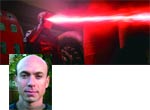
Stephen Rosenbaum (inset) was Cinesite's visual effects supervisor for X2. He reports that the Cyclops' effects were created using Houdini and rendered in Mantra.
|
HOLLYWOOD - Even as the powers-that-be at Cinesite Hollywood were announcing the studio's departure from the world of feature film visual effects, their artists were hard at work finishing 300-plus shots for X-Men 2, directed by Bryan Singer. The story follows a group of mutants with superpowers, and the Cinesite Hollywood (www.cinesite.com) team helped shape each character's personality and how it was expressed through their powers.
In the sequel, the mutants face discrimination after a devastating attack is attributed to their kind. Visual effects supervisor Mike Fink orchestrated the gargantuan effects effort. For Cinesite, Stephen Rosenbaum was visual effects supervisor and Scott Dougherty was executive producer. "We had to be very flexible in order to accommodate a project of this size," notes Rosenbaum. "We brought in a lot of quality talent to handle the work on time without compromises."
All the characters from the original film, which Cinesite also worked on, return and are augmented by new superheroes. "Working with these characters is interesting because as you're developing substantive characters, you're developing back story and building up future stories," says Rosenbaum.

Kleiser-Walczak (www.kwcc.com) further defined the 3D morphing technique it used on X-Men for X-Men 2. The VFX studio supplied over 50 shots, produced by Molly Windover and supervised by Frank Vitz. Sofware used includes Maya, Shake, Combustion, Freeform, Furnace and Deep Paint. Platforms were NT, Mac and SGI.
|
Powerful characters
Cinesite worked on every mutant character in the film except Mystique, whose shots were handled by Kleiser-Walzack. Rhythm & Hues also contributed some shots. One new effect is a teleportation trick performed by Nightcrawler. He is able to disappear from one place and reappear in another - known as "Bamfing." Nightcrawler "Bamfs" several times in a single, moving shot. The production used a motion control system, shooting several passes of each camera move at 72fps. In post, the actor's harnesses were rotoscoped using Cineon or painted out using the proprietary software mooVPaint. To enhance the effect, CG supervisor Greg Anderson used a combination of Side Effects Houdini and an in-house particle system so that just before disappearing Nightcrawler exudes smoke. Just after he disappears the smoke is sucked inwards, leaving a residue of blue smoke.
Dr. Jean Gray returns with telekinetic powers. Storm and her ability to control weather also play a part. Kitty has the ability to pass through solid surfaces. Pyro sets things on fire. Rogue is a mutant who touches people and takes on their powers. Logan has the ability to heal; some of those effects were done in Cineon using painted mattes. Cyclops emits a powerful beam from his eye that actually consisted of several elements, including a red glow and a gaseous feeling.
As much as one-third of Cinesite's work on the film involves Cerebro, the device Xavier uses to communicate with the mutants. This effect was redesigned to be more abstract and ethereal.
The Cerebro effect begins with a digital set extension shot made in Alias|Wavefront Maya, in which CG portions of the spherical room are composited using Apple Shake with actual built sets photographed as wide as an 8mm lens. As the effect begins, a matte-painted element created in Adobe Photshop of a map and made of multiple 3D volumetric layers is projected on the inside of the sphere. A huge flash of white light transitions the shots to the actual effect. White represents people, and red light represents mutants. The various mutants and people flash by trailing diaphanous vapors and are tied into beams of light that project toward Xavier or the operator. The people were photographed against greenscreen in silhouette or three-quarter backlight, and composited with Shake into a spherical volume.
"We wanted to make the experience of being in Cerebro much more graphic and visually interesting," explains Rosenbaum. "We wanted it to be nebula-like, with dimension and depth. We did some pre-visualization in Maya and Cyborg, and the producer liked our ideas. We made some adjustments to make it clearer to the audience how it worked, and how it could be manipulated for [evil]. All in all, Cerebro involved close to 100 shots."
Approximately three dozen shots involve composites of practical and CG fire created in Houdini, and another dozen or so involve creating vaporous ice particles or physical blocks of ice created with Maya and Pixar RenderMan. Bobby Drake, a.k.a. Iceman, creates frosty vapor and freezes objects to immobilize them. "Ice is never as trivial as a CG effect because it's difficult to light and it has a subsurface luminous quality that's difficult to replicate," says Rosenbaum. "It's not just a flatly shaded surface you project light onto and it's reflected back. It has layers to it. It scatters light, absorbs and scatters light within it. We wrote shaders in RenderMan to animate and shade the huge ice wall that Bobby creates."
Rosenbaum looks forward to seeing audiences react to X2. "There are legions of dedicated fans out there," he says. "We want to make sure our work holds up to their high standards. It's fun to work with stories where the effects are so tied into the personalities of the characters. You really feel [like] part of the creative process."